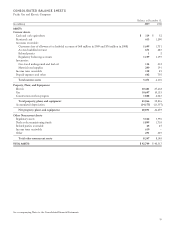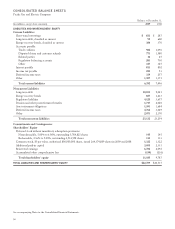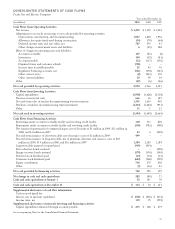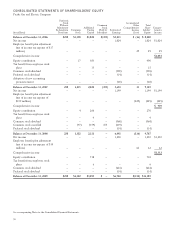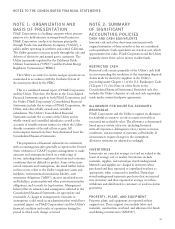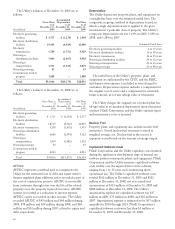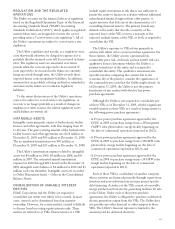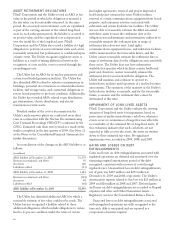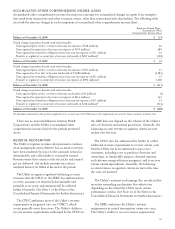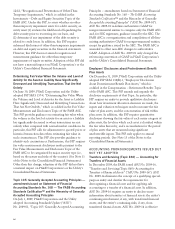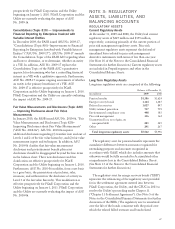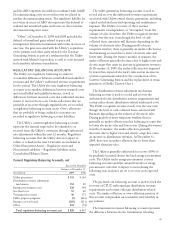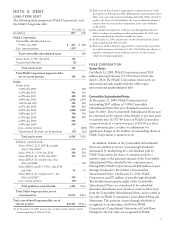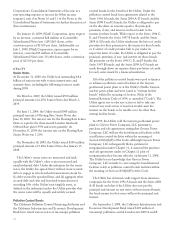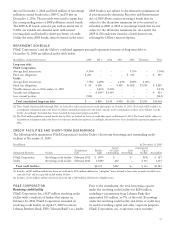PG&E 2009 Annual Report Download - page 68
Download and view the complete annual report
Please find page 68 of the 2009 PG&E annual report below. You can navigate through the pages in the report by either clicking on the pages listed below, or by using the keyword search tool below to find specific information within the annual report.authorized by the FERC is dependent on the volume of
the Utility’s electricity sales, and revenue is recognized only
for amounts billed.
In determining whether revenue transactions should be
presented net of the related expenses, the Utility considers
various factors, including whether the Utility takes title to
the product being delivered, has latitude in establishing
price for the product, and is subject to the customer credit
risk. In January 2001, the California Department of Water
Resources (“DWR”) began purchasing electricity to meet
the portion of demand of the California investor-owned
electric utilities that was not being satisfied from the
utilities’ own generation facilities and existing electricity
contracts. The Utility acts as a billing and collection agent
on behalf of the DWR and does not have any authority to
set prices for the energy delivered. The Utility does not
assume customer credit risk nor take title to the electricity
being delivered to the customer. Therefore, the Utility
presents the electricity revenues for amounts delivered to
customers net of the cost of electricity delivered by the
DWR.
INCOME TAXES
PG&E Corporation and the Utility use the liability method
of accounting for income taxes. Income tax provision
(benefit) includes current and deferred income taxes
resulting from operations during the year. Investment tax
credits are amortized over the life of the related property.
(See Note 9 of the Notes to the Consolidated Financial
Statements for further discussion of income taxes.)
PG&E Corporation files a consolidated U.S. federal
income tax return that includes domestic subsidiaries in
which its ownership is 80% or more. In addition, PG&E
Corporation files a combined state income tax return in
California. PG&E Corporation and the Utility are parties to
a tax-sharing agreement under which the Utility determines
its income tax provision (benefit) on a stand-alone basis.
NUCLEAR DECOMMISSIONING TRUSTS
The Utility classifies its investments held in the nuclear
decommissioning trust as “available-for-sale.” As the
day-to-day investing activities of the trusts are managed by
external investment managers, the Utility is unable to assert
that it has the intent and ability to hold investments to
maturity or that it is more likely than not that the Utility
will be required to sell the investments. Therefore, all
unrealized losses are considered other-than-temporary
impairments. Gains or losses on the nuclear
decommissioning trust investments are refundable or
recoverable, respectively, from customers. Therefore, trust
earnings are deferred and included in the regulatory
liability for recoveries in excess of the ARO. There is no
impact on the Utility’s earnings or accumulated other
comprehensive income. The cost of debt and equity
securities sold is determined by specific identification. (See
Note 12 of the Notes to the Consolidated Financial
Statements for further discussion.)
ACCOUNTING FOR DERIVATIVES
AND HEDGING ACTIVITIES
Derivative instruments are recorded in PG&E
Corporation’s and the Utility’s Consolidated Balance
Sheets at fair value, unless they qualify for the normal
purchase and sales exception. Changes in the fair value of
derivative instruments are recorded in earnings or, to the
extent that they are recoverable through regulated rates, are
deferred and recorded in regulatory accounts. Derivative
instruments may be designated as cash flow hedges when
they are entered into in order to hedge variable price risk
associated with the purchase of commodities. For cash flow
hedges, fair value changes are deferred in accumulated
other comprehensive income and recognized in earnings as
the hedged transactions occur, unless they are recovered in
rates, in which case they are recorded in regulatory
accounts.
As of September 30, 2009, the Utility de-designated all
cash flow hedge relationships. Due to the regulatory
accounting treatment described above, the de-designation
of cash flow hedge relationships had no impact on Income
Available for Common Shareholders or the Consolidated
Balance Sheets.
The normal purchase and sales exception to derivative
accounting requires, among other things, physical delivery
of quantities expected to be used or sold over a reasonable
period in the normal course of business. Transactions for
which the normal purchase and sales exception is elected
are not reflected in the Consolidated Balance Sheets at fair
value. They are accounted for under the accrual method of
accounting. Therefore, expenses are recognized as incurred.
PG&E Corporation and the Utility offset the cash
collateral paid or cash collateral received against the fair
value amounts recognized for derivative instruments
executed with the same counterparty under a master
netting arrangement where the right of offset exists and
where PG&E Corporation and the Utility intends to set off.
See Note 10 of the Notes to the Consolidated Financial
Statements for further discussion and financial statement
impact.
FAIR VALUE MEASUREMENTS
PG&E Corporation and the Utility determine the fair value
of certain assets and liabilities based on assumptions that
64



